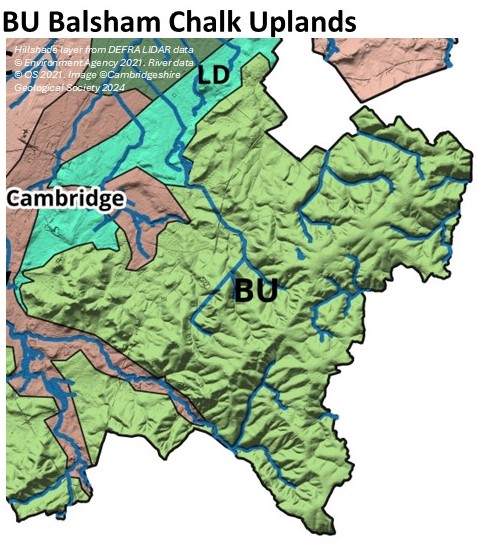

Balsham Chalk Uplands
There are two areas of higher ground in the southern part of the county, the Balsham & Heydon Chalk Uplands, which are separated by the Granta & Cam valleys. The rolling landscape is dissected by small streams, with a degraded chalk escarpment facing northwest. There is a fragmented southwest-northeast aligned ridge reaching above 100m OD underlain by Lowestoft Fm Glacial Till that typically forms heavy poorly drained soils. Patches of Head, Fan Deposits & Glacial Gravels are present in a variety of settings. The Zig Zag, Holywell, New Pit & Lewes Chalk Formations give rise to thin free draining soils.
The Balsham Chalk Uplands landscape adjoins Suffolk and Essex and includes the headwaters of the southward flowing River Stour. It is also located between the Cam Valley to the west and the Lode Apron to the northwest.
There are no geological SSSI, but 9 LGS in the Balsham Chalk Uplands (mostly springs, representing different features of the Chalk succession, and chalk pits):
LGS:
Chalk springs arising from the Totternhoe Stone – Giants Grave, Cambridge: Nine Wells, nr Shelford: Castle Spring, Burwell
Chalk Pits – Carter’s Pit LGS, Burwell (Zig Zag Chalk): West Pit, Cherry Hinton (Totternhoe Stone, Zig Zag Chalk): East Pit LGS, Cherry Hinton (ZIg Zag Chalk, Melbourn Rock, Holywell Nodular Chalk): Stapleford Parish Pit (New Pit Chalk).


The Chalk
Chalk is a type of limestone that dates from the Cretaceous period having been formed between about 90 and 99 million years ago, mostly from the carbonate remains of marine algae and various animals that sank to the bottom of a relatively warm, deep sea. These chalk hills extend south and north, linking our local ‘uplands’ with the Chilterns, the North and South Downs and, in the north, the Yorkshire Wolds.
Within the Chalk there are numerous layers (called formations), each with its own characteristics and most made up of several beds of different material. Some beds within the chalk are relatively hard and the rock has been used for building stone, whilst others, called marls, are soft as they contain higher levels of clay minerals. The type and quantity of fossils in each layer is also distinctive and enables geologists to trace the formations across, not only the country, but also the London-Paris basin and even further afield.
Two of the harder bands of chalk that can be seen in Cambridgeshire are named after local places. The most famous is the Totternhoe Stone, named after Totternhoe in Bedfordshire, which was formed about 95-96 million years ago and has been used for many local buildings including some of the colleges in Cambridge. It was quarried at a number of locations in the south of the county including Cherry Hinton and Burwell, hence its other name of Burwell Rock, The second is the Melbourn Rock, named after the village of Melbourn in Cambridgeshire, which is a little younger at roughly 93-94 million years old. Due to the fact that water can easily flow through fissures in these hard bands and that they lie above layers of far less permeable chalk marls, they are each associated with a spring line that feeds ecologically important chalk streams that flow into the Cam Valley. The Melbourn Rock underlies the change in slope on which Beechwoods Nature Reserve lies and outcrops of it can be seen in the woodland.
In the past, many fossils were found in the chalk quarries of Cambridgeshire and several of these can now be seen at the Sedgwick Museum of Earth Science in Cambridge. There are no longer good sites for collecting, however, as most of the quarries are now disused and infilled and most fossils have been removed.


The Gog Magogs are chalk hills to the south of Cambridge which have a rich cultural heritage due to their significant prehistoric sites. They are also important ecologically for their chalk grassland flora and associated fauna.



East Pit, Cherry Hinton, containing deposits of Grey Chalk at the bottom of the cliffs and White Chalk towards the top. The layer of the Plenus Marls lies part way up the cliff face under the harder band of the Melbourn Rock.